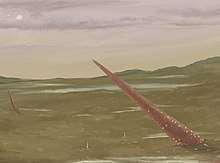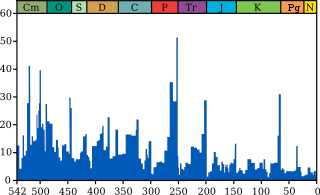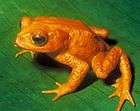Ordovician–Silurian extinction events
The Ordovician–Silurian extinction events, when combined, are the second-largest of the five major extinction events in Earth's history in terms of percentage of genera that became extinct. This event greatly affected marine communities, which caused the disappearance of one third of all brachiopod and bryozoan families, furthermore numerous groups of conodonts, trilobites, and graptolites.[1] The Ordovician–Silurian extinction occurred during the Hirnantian stage of the Ordovician Period and the subsequent Rhuddanian stage of the Silurian Period.[2] The last event is dated in the interval of 455 to 430 million years ago, lasting from the Middle Ordovician to Early Silurian, thus including the extinction period.[3] This event was the first of the big five Phanerozoic events and was the first to significantly affect animal-based communities.[4]
Almost all major taxonomic groups were affected during this extinction event. Extinction was global during this period, eliminating 49–60% of marine genera and nearly 85% of marine species.[5]
Brachiopods, bivalves, echinoderms, bryozoans and corals were particularly affected.[6] Before the late Ordovician cooling, temperatures were relatively warm and it is the suddenness of the climate changes and the elimination of habitats due to sea-level fall that are believed to have precipitated the extinctions.[7] The falling sea level disrupted or eliminated habitats along the continental shelves.[6][8] Evidence for the glaciation was found through deposits in the Sahara Desert. A combination of lowering of sea level and glacially driven cooling were likely driving agents for the Ordovician mass extinction.[8]
Impact
The extinction occurred 443.8 million years ago, during the Great Ordovician Biodiversification Event.[9] It marks the boundary between the Ordovician and following Silurian period. During this extinction event there were several marked changes in biologically responsive carbon and oxygen isotopes. The spread of anoxia (the absence of oxygen) greatly affected the organisms that lived in this time period.[10] This complexity may indicate several distinct closely spaced events, or particular phases within one event.
At the time, most complex multicellular organisms lived in the sea, and around 100 marine families became extinct, covering about 49%[11] of faunal genera (a more reliable estimate than species). The brachiopods and bryozoans were decimated, along with many of the trilobite, conodont and graptolite families.
Statistical analysis of marine losses at this time suggests that the decrease in diversity was mainly caused by a sharp increase in extinctions, rather than a decrease in speciation.[12] Several groups of marine organisms with a planktonic lifestyle, more exposed to UV radiation than groups that lived in the benthos, suffered severely during the late Ordovician. Organisms that dwelled in the plankton were affected before benthic organisms during the mass extinction, and species dwelling in shallow water were more likely to become extinct than species dwelling in deep water.[7]
Possible causes

The rapid onset of the continental glaciation on Gondwana determined by its position in the South Pole area; the cooling; the hydrodynamic changes through the entire water column in the World Ocean; and the corresponding sea level fall, which was responsible for the reduction of shelf areas and shallow-water basins, i.e., the main ecological niche of the Ordovician marine biota, were main prerequisites of the stress conditions. Similar to other mass extinction events, these processes were accompanied by volcanism, impact events, a corresponding reduction of the photosynthesis and bioproductivity, the destruction of food chains, and anoxia. The appearance and development of terrestrial plants and microphytoplankton, which consumed atmospheric carbon dioxide, thus, diminishing the greenhouse effect and promoting the transition of the climatic system to the glacial mode, played a unique role in that period.[3]
Glaciation
Two environmental changes associated with the glaciation were responsible for much of the Late Ordovician extinction. First, the cooling global climate was probably especially detrimental because the biota were adapted to an intense greenhouse. Second, sea level decline, caused by sequestering of water in the ice cap, drained the vast epicontinental seaways and eliminated the habitat of many endemic communities.
Glaciation pulses appear to correspond to the beginning and end of the most severe ice age of the Phanerozoic, which marked the end of a longer cooling trend in the Hirnantian faunal stage towards the end of the Ordovician,[9] which had more typically experienced greenhouse conditions.
As the southern supercontinent Gondwana drifted over the South Pole, ice caps formed on it. Correlating rock strata have been detected in Late Ordovician rock strata of North Africa and then-adjacent northeastern South America, which were south-polar locations at the time. Glaciation locks up water from the world-ocean, and the interglacials free it, causing sea levels repeatedly to drop and rise; the vast shallow mediterranean Ordovician seas withdrew, which eliminated many ecological niches, then returned, carrying diminished founder populations lacking many whole families of organisms. Then they withdrew again with the next pulse of glaciation, eliminating biological diversity at each change (Emiliani 1992 p. 491). In the North African strata, five pulses of glaciation from seismic sections are recorded.[13]
This incurred a shift in the location of bottom-water formation, shifting from low latitudes, characteristic of greenhouse conditions, to high latitudes, characteristic of icehouse conditions, which was accompanied by increased deep-ocean currents and oxygenation of the bottom-water. An opportunistic fauna briefly thrived there, before anoxic conditions returned. The breakdown in the oceanic circulation patterns brought up nutrients from the abyssal waters. Surviving species were those that coped with the changed conditions and filled the ecological niches left by the extinctions.
Gamma-ray burst
Some scientists have suggested that the initial extinctions could have been caused by a gamma-ray burst originating from a hypernova within 6,000 light-years of Earth (in a nearby arm of the Milky Way galaxy). A ten-second burst would have stripped the Earth's atmosphere of half of its ozone almost immediately, exposing surface-dwelling organisms, including those responsible for planetary photosynthesis, to high levels of extreme ultraviolet radiation.[7][14][15][16] Although the hypothesis is consistent with patterns at the onset of extinction, there is no unambiguous evidence that such a nearby gamma-ray burst ever happened.
Volcanism and weathering
The late Ordovician glaciation was preceded by a fall in atmospheric carbon dioxide (from 7,000 ppm to 4,400 ppm).[17][18] The dip is correlated with a burst of volcanic activity that deposited new silicate rocks, which draw CO2 out of the air as they erode. A major role of CO2 is implied by a 2009 paper.[19] Atmospheric and oceanic CO2 levels may have fluctuated with the growth and decay of Gondwanan glaciation.[10] Through the Late Ordovician, outgassing from major volcanism was balanced by heavy weathering of the uplifting Appalachian Mountains, which sequestered CO2. In the Hirnantian Stage the volcanism ceased, and the continued weathering caused a significant and rapid draw down of CO2.[18] This coincides with the rapid and short ice age.
Metal poisoning
Toxic metals on the ocean floor may have dissolved into the water when the oceans' oxygen was depleted. An increase in available nutrients in the oceans may have been a factor, and decreased ocean circulation caused by global cooling may also have been a factor. [20]
The toxic metals may have killed life forms in lower trophic levels of the food chain, causing a decline in population, and subsequently resulting in starvation for the dependent higher feeding life forms in the chain.[21][22]
End of the event
The end of the second event occurred when melting glaciers caused the sea level to rise and stabilize once more. The rebound of life's diversity with the sustained re-flooding of continental shelves at the onset of the Silurian saw increased biodiversity within the surviving orders.
Following such a major loss of diversity, Silurian communities were initially less complex and broader niched. Highly endemic faunas, which characterized the Late Ordovician, were replaced by faunas that were amongst the most cosmopolitan in the Phanerozoic, biogeographic patterns that persisted throughout most of the Silurian.[4]
These end Ordovician–Silurian events had nothing like the long-term impact of the Permian–Triassic and Cretaceous–Paleogene extinction events. Nevertheless, a large number of taxa disappeared from the Earth over a short time interval,[4] eliminating and changing diversity.
See also
- Anoxic event
- Cretaceous–Paleogene extinction event
- Global catastrophic risk
- Late Devonian extinction
- Near-Earth supernova
- Permian–Triassic extinction event
- Triassic–Jurassic extinction event
- Andean-Saharan glaciation[23]
Sources
- Elewa, Ashraf (2008). Late Ordovician Mass Extinction. p. 252. ISBN 978-3-540-75915-7.
- "Ordovician–Silurian extinction". Encyclopædia Britannica. Retrieved 2016-04-06.
- Barash, M. (November 2014). "Mass Extinction of the Marine Biota at the Ordovician–Silurian Transition Due to Environmental Changes". Oceanology. 54 (6): 780–787. Bibcode:2014Ocgy...54..780B. doi:10.1134/S0001437014050014.
- Harper, D. A. T.; Hammarlund, E. U.; Rasmussen, C. M. Ø. (May 2014). "End Ordovician extinctions: A coincidence of causes". Gondwana Research. 25 (4): 1294–1307. Bibcode:2014GondR..25.1294H. doi:10.1016/j.gr.2012.12.021.
- Christie, M.; Holland, S. M.; Bush, A. M. (2013). "Contrasting the ecological and taxonomic consequences of extinction". Paleobiology. ProQuest 1440071324.
- Sole, R. V.; Newman, M. (2002). "The earth system: biological and ecological dimensions of global environment change". Encyclopedia of Global Environmental Change, Volume Two: Extinctions and Biodiversity in the Fossil Record. John Wiley & Sons. pp. 297–391.
- Melott, A.L.; et al. (2004). "Did a gamma-ray burst initiate the late Ordovician mass extinction?". International Journal of Astrobiology. 3 (2): 55–61. arXiv:astro-ph/0309415. Bibcode:2004IJAsB...3...55M. doi:10.1017/S1473550404001910.
- "Causes of the Ordovician Extinction". Archived from the original on 2008-05-09.
- Munnecke, A.; Calner, M.; Harper, D. A. T.; Servais, T. (2010). "Ordovician and Silurian sea-water chemistry, sea level, and climate: A synopsis". Palaeogeography, Palaeoclimatology, Palaeoecology. 296 (3–4): 389–413. doi:10.1016/j.palaeo.2010.08.001.
- "Get it! Helper Window | University of Toronto Libraries". simplelink.library.utoronto.ca. Retrieved 2016-04-08.
- Rohde & Muller; Muller, RA (2005). "Cycles in Fossil Diversity". Nature. 434 (7030): 208–210. Bibcode:2005Natur.434..208R. doi:10.1038/nature03339. PMID 15758998.
- Bambach, R.K.; Knoll, A.H.; Wang, S.C. (December 2004). "Origination, extinction, and mass depletions of marine diversity". Paleobiology. 30 (4): 522–542. doi:10.1666/0094-8373(2004)030<0522:OEAMDO>2.0.CO;2.
- "Archived copy" (PDF). Archived from the original (PDF) on 2011-07-27. Retrieved 2009-07-22.CS1 maint: archived copy as title (link) IGCP meeting September 2004 reports pp 26f
- Wanjek, Christopher (April 6, 2005). "Explosions in Space May Have Initiated Ancient Extinction on Earth". NASA. Retrieved 2008-04-30.
- "Ray burst is extinction suspect". BBC. April 6, 2005. Retrieved 2008-04-30.
- Melott, A.L. & Thomas, B.C. (2009). "Late Ordovician geographic patterns of extinction compared with simulations of astrophysical ionizing radiation damage". Paleobiology. 35 (3): 311–320. arXiv:0809.0899. doi:10.1666/0094-8373-35.3.311.
- Seth A. Young, Matthew R. Saltzman, William I. Ausich, André Desrochers, and Dimitri Kaljo, "Did changes in atmospheric CO2 coincide with latest Ordovician glacial–interglacial cycles?", Palaeogeography, Palaeoclimatology, Palaeoecology, Vol. 296, No. 3–4, 15 October 2010, Pages 376–388.
- Jeff Hecht, High-carbon ice age mystery solved, New Scientist, 8 March 2010 (retrieved 30 June 2014)
- Young. S.A.; et al. (2009). "A major drop in seawater 87Sr/86Sr during the Middle Ordovician (Darriwilian): Links to volcanism and climate?" (PDF). Geology. 37 (10): 951–954. Bibcode:2009Geo....37..951Y. doi:10.1130/G30152A.1. Retrieved 2017-10-23.
- "Abrupt global-ocean anoxia during the Late Ordovician–early Silurian detected using uranium isotopes of marine carbonates". Retrieved 2020-03-25.
- Katz, Cheryl (2015-09-11). "New Theory for What Caused Earth's Second-Largest Mass Extinction". National Geographic News. Retrieved 2015-09-12.
- Vandenbroucke, Thijs R. A.; Emsbo, Poul; Munnecke, Axel; Nuns, Nicolas; Duponchel, Ludovic; Lepot, Kevin; Quijada, Melesio; Paris, Florentin; Servais, Thomas (2015-08-25). "Metal-induced malformations in early Palaeozoic plankton are harbingers of mass extinction". Nature Communications. 6. Article 7966. Bibcode:2015NatCo...6.7966V. doi:10.1038/ncomms8966. PMC 4560756. PMID 26305681.
- "The history of ice on Earth". newscientist.com. Retrieved 12 April 2018.
Further reading
- Gradstein, Felix M.; Ogg, James G.; Smith, Alan G. (2004). A Geological Time Scale 2004 (3rd ed.). Cambridge University Press: Cambridge University Press. ISBN 9780521786737.
- Hallam, Anthony; Paul B., Wignall (1997). Mass Extinctions and Their Aftermath. Oxford University Press. ISBN 9780191588396.
- Webby, Barry D.; Paris, Florentin; Droser, Mary L.; Percival, Ian G, eds. (2004). The great Ordovician biodiversification event. New York: Columbia University Press. ISBN 9780231501637.
External links
- Jacques Veniers, "The end-Ordovician extinction event": abstract of Hallam and Wignall, 1997.

